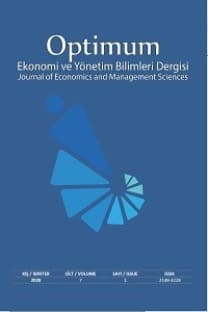Türkiye’de Petrol Fiyatlarından Enflasyona Asimetrik ve Doğrusal Olmayan Geçişkenlik
Ham Petrol Fiyatları, Asimetrik Geçişkenlik, Enflasyon, NARDL
Asymmetric and Nonlinear Pass-Through of Global Crude Oil Price to Inflation in Turkey
Crude Oil Prices, Asymmetric Pass-through, Inflation, NARDL,
___
- Bala, U., & Chin, L. (2018). Asymmetric Impacts of Oil Price on Inflation : An Empirical Study of African OPEC Member Countries, (August). https://doi.org/10.20944/preprints201808.0064.v1
- Blanchard, O. J., & Galí, J. (2007). The Macroeconomic Effects of Oil Price Shocks: Why are the 2000s so different from the 1970s? NBER Chapters. https://doi.org/10.1017/CBO9781107415324.004
- Çatik, A. N., & Karaçuka, M. (2012). Oil pass-through to domestic prices in Turkey: Does the change in inflation regime matter? Ekonomska Istrazivanja, 25(2), 277–296. https://doi.org/10.1080/1331677X.2012.11517508
- Chen, S. S. (2009). Oil price pass-through into inflation. Energy Economics. https://doi.org/10.1016/j.eneco.2008.08.006
- Chinn, M., & Leblanc, M. (2004). Do High Oil Prices Presage Inflation ? Business Economics. https://doi.org/4aabcd045a8ec14c0d08ecd330968821
- Choi, B. S., Furceri, D., Loungani, P., Mishra, S., & Poplawski-Ribeiro, M. (2017). Oil Prices and Inflation Dynamics: Evidence from Advanced and Developing Economies. IMF Working Paper, 55.
- Conflitti, C., & Luciani, M. (2017). Oil Price Pass-Through into Core Inflation. Ssrn. https://doi.org/10.2139/ssrn.3082191
- Dedeoǧlu, D., & Kaya, H. (2014). Pass-through of oil prices to domestic prices: Evidence from an oil-hungry but oil-poor emerging market. Economic Modelling, 43(February 2001), 67–74. https://doi.org/10.1016/j.econmod.2014.07.038
- ECB. (2010). Oil Prices – Their Determinants and Impact on Euro Area Inflation and the Macroeconomy. Monthly Bulletin, (August), 75–92.
- Engle, R. F. (1982). Autoregressive Conditional Heteroscedasticity with Estimates of the Variance of United Kingdom Inflation. Econometrica. https://doi.org/10.2307/1912773
- Engle, R. F., & Granger, C. W. J. (1987). Co-Integration and Error Correction: Representation, Estimation, and Testing. Econometrica, 55(2), 251. https://doi.org/10.2307/1913236
- Hamilton, J. D., & Herrera, A. M. (2004). Oil Shocks and Aggregate Macroeconomic Behavior: The Role of Monetary Policy: A Comment. Journal of Money, Credit, and Banking. https://doi.org/10.1353/mcb.2004.0012
- Hooker, M. A. (2000). Are Oil Shocks Inflationary? Asymmetric and Nonlinear Specifications Versus Changes in Regime. Ssrn. https://doi.org/10.2139/ssrn.208890
- Lacheheb, M., & Sirag, A. (2016). Oil Price and inflation in Algeria : A nonlinear ARDL approach. Topics in Middle Eastern and African Economics, 18(2), 45–60.
- Long, S., & Liang, J. (2018). Asymmetric and nonlinear pass-through of global crude oil price to China’s PPI and CPI inflation. Economic Research-Ekonomska Istrazivanja, 31(1), 240–251. https://doi.org/10.1080/1331677X.2018.1429292
- Mork, K. A. (1989). Oil and the Macroeconomy When Prices Go Up and Down: An Extension of Hamilton’s Results. Journal of Political Economy. https://doi.org/10.1086/261625
- Öztürkler, H., Demir, F., & Yılmaz, S. (2015). Crude Oil Price Pass-Through to Domestic Prices in Turkey: Asymmetric Nonlinear ARDL Approach. EY International Congress on Economics II, (256), 1–14.
- Pesaran, M. H., Shin, Y. (1999). An autoregressive distributed lag modelling approach to cointegration analysis. In Econometrics and Economic Theory in the 20th Century: The Ragnar Frisch Centennial Symposium. (pp. 1–31). https://doi.org/10.1017/CCOL521633230
- Pesaran, M. H., Shin, Y., & Smith, R. J. (2001). Bounds testing approaches to the analysis of level relationships. Journal of Applied Econometrics, 16(3), 289–326. https://doi.org/10.1002/jae.616
- Shin, Y., Yu, B., & Greenwood-Nimmo, M. (2013). Modelling Asymmetric Cointegration and Dynamic Multipliers in a Nonlinear ARDL Framework. SSRN. https://doi.org/10.2139/ssrn.1807745
- Zhao, L., Zhang, X., Wang, S., & Xu, S. (2016). The effects of oil price shocks on output and inflation in China. Energy Economics, 53, 101–110. https://doi.org/10.1016/j.eneco.2014.11.017
- Yayın Aralığı: Yılda 2 Sayı
- Başlangıç: 2014
- Yayıncı: -
Zeki YILMAZ, Pınar ÖZER, Feride Gülsüm GÜMÜŞSOY
Vergi Denetim Algısına Sahip Vergi Mükelleflerinin Vergi Adaleti ve Vergi Affı Uygulamalarına Bakışı
Mustafa TAYTAK, Tuğba AKYÜZ DALKIRAN
Ticari Dışa Açıklığın Bölgesel İşsizlik Üzerindeki Etkisi: Türkiye Örneği
Kuşaklar Arası Etkileşimin Marka Bağlılığı Üzerindeki Rolü: Takım Taraftarlığı Üzerine Bir Araştırma
Seçilmiş İslam Ülkeleri İçin Satın Alma Gücü Paritesinin Geçerliliği Üzerine Bir Çalışma
Ekonomik Kalkınmada Birleştirici Sosyal Sermaye Üzerine Bir İnceleme
Türkiye’de Petrol Fiyatlarından Enflasyona Asimetrik ve Doğrusal Olmayan Geçişkenlik
İlk Evlilik Süresini Etkileyen Faktörlerin Yaşam Analizi: Türkiye Örneği
Şahika GÖKMEN, Anıl ERALP, Aliye ATAY KAYIŞ
Hisse Senedi Getirilerinin Marka Değeri Duyurularına Tepkisi
